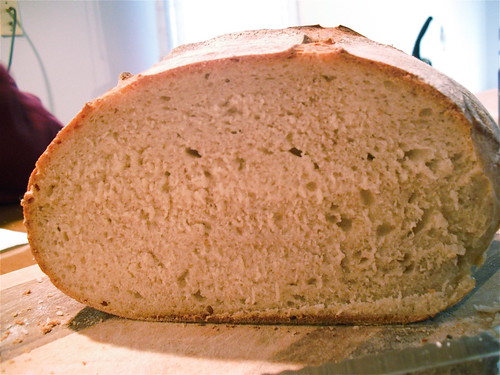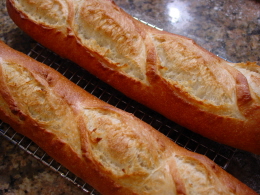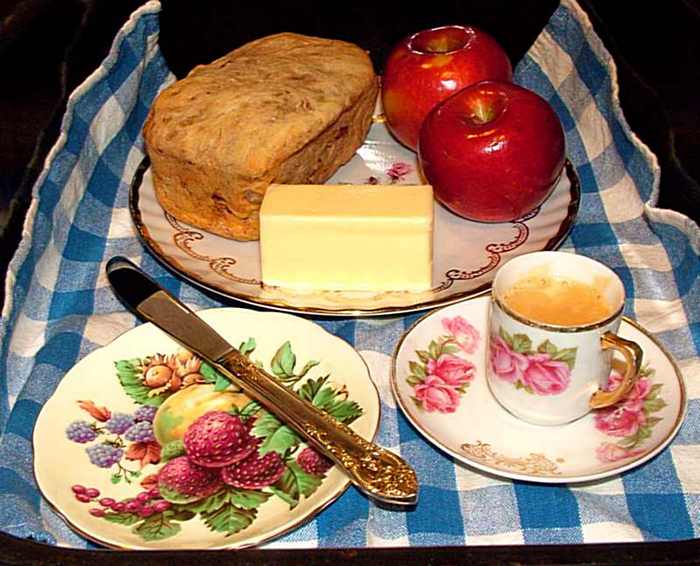This past Friday I purchased a 4 lb. bag of Granny Smith apples with the intentions of eating some plain, and incorporating some into my fruit smoothies..Well, I had too much other fruit on hand, and the apples sat until this morning untouched..As they were starting to show soft spots where they had ben bruised during picking and transportation, I decided to use the entire 4 lbs. in a batch of 20 Hour Apples..
http://www.thefreshloaf.com/node/11218/20hour-apples-are-absolutely-fantastic
Being in somewhat of a hurry, I decided to incorporate some of the suggested short cuts that were mentioned by various posters in the above thread that I started back on March 21st..One poster mentioned using a slow cooker (crock pot), and other posters mentioned that Chef Herme's methodology for the ultra thin slicing and layering seemed to be unnecessary, as well as too fussy..
After peeling, coring (was not very meticulous about getting all of the core), and quartering the apples I was left with 2 lb. 4 oz. of yield..I elected to slice each quarter lengthwise into three to four 1/4" thick slices..I had juiced up all of the citrus fruits that I had on hand Friday night so I elected to spice things up a little with additional spices other than cinnamon..
20 Hour Apples--Redux
4 lb. Granny Smith apples--peeled, cored, quartered, sliced lengthwise into 1/4" slices
1lb. 8 oz. whole strawberries, stems pinched off as closely as possible (frozen for smoothies)
8 oz. organic granulated cane juice
1 1/4 teaspoons ground cinnamon
1/2 teaspoon ground cardamom
1/4 teaspoon ground cloves
1/8 teaspoon ground cayenne pepper
1 whole vanilla bean, split lengthwise in half, scraped out, mixed into the sugar
Instead of using a baking dish wrapped in plastic wrap weighted with a pan on top of the plastic wrap, I elected to use a Farberware Millenium hard anodized alluminum 4 quart stock pot to cook the apples in..First, I placed the scraped out sections of the vanilla bean in the bottom of the pot..Then, I layered the apple slices so as to cover as completely as possible the bottom surface of the pot..Then, I sprinkled a generous amount of the sugar-cinnamon-cardamom-cloves-cayenne pepper-vanilla bean mixture onto the apples..I repeated the apples and sugar mixture two more times..These three layers used up about 50% of the sliced apples, and the stock pot was not quite 1/2 full..Then, I remembered that I had approximately 1.5 pounds of whole strawberries in the freezer to use in smoothies..I pinch off the stems as close to the strawberry as possible when prepping them for freezing (the tiny amount of stem left on the strawberry disappears in the smoothie)..For some reason I wanted the pot to be as full as possible before I started baking the apples..Accordingly, I used the entire 1.5 pounds of frozen whole berries to create a layer of strawberries on top of the first half of the apples..I sprinkled the berries with the sugar mixture, and finished layering the remaining apples in three additional layers..The one cup (8 oz.) of sugar was the perfect amount for the 6 layers of apples, and the single layer of berries..None left over..
The pot, with its relatively tight fitting lid, went into the 175F oven at 12 noon..My intentions are to let the apples and strawberries cook until 6 AM Monday morning..What I am shooting for is an apple-strawberry jam with the apples being cooked completely down..I will post back to let everyone know how this experiment turns out..
Bruce












